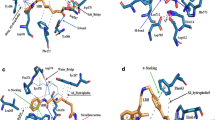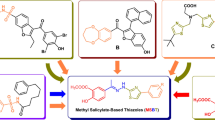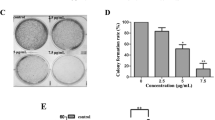Abstract
Aim:
To investigate the anticancer property and possible mechanism of action of a novel sugar-substituted thalidomide derivative (STA-35) on HL-60 cells in vitro.
Methods:
TNF-α-induced NF-κB activation was determined using a reporter gene assay. The MTT assay was used to measure cytotoxicity of the compound. The appearance of apoptotic Sub-G1 cells was detected by flow cytometry analysis. PARP cleavage and protein expression of NF-κB p65 and its inhibitor IκB were viewed by Western blotting.
Results:
STA-35 (1–20 μmol/L) suppressed TNF-α-induced NF-κB activation in transfected cells (HEK293/pNiFty-SEAP) in a dose- (1–20 μmol/L) and time-dependent (0–48 h) manner. It was also shown that STA-35 exerted a dose-dependent inhibitory effect on HL-60 cell proliferation with an IC50 value of 9.05 μmol/L. In addition, STA-35 induced apoptosis in HL-60 cells, as indicated by the appearance of a Sub-G1 peak in the cell cycle distribution, as well as poly ADP-ribose polymerase (PARP) cleavage. Subsequently, both NF-κB p65 and its inhibitor IκB gradually accumulated in cytoplasmic extracts in a dose- and time-dependent manner, indicating the blockage of NF-κB translocation induced by TNF-α from the cytoplasm to the nucleus.
Conclusion:
A novel sugar-substituted thalidomide derivative, STA-35, is potent toward HL-60 cells in vitro and induces apoptosis by the suppression of NF-κB activation.
Similar content being viewed by others
Log in or create a free account to read this content
Gain free access to this article, as well as selected content from this journal and more on nature.com
or
Abbreviations
- DMSO:
-
dimethyl sulfoxide
- NF-κB:
-
nuclear factor-κB
- IκB:
-
Inhibitor of κB
- MTT:
-
3-(4,5-dimethylthiazol-2-yl)-2,5-diphenyltetrazolium bromide
- TNF-α:
-
tumor necrosis factor-α
References
Sen R, Baltimore D . Inducibility of kappa immunoglubin enhancer-binding protein NF-kappa B by a posttranslational mechanism. Cell 1986; 47: 921–8.
Olivier S, Robe P, Bours V . Can NF-кB be a target for novel and efficient anti-cancer agents? Biochem Pharmacol 2006; 72: 1054–68.
Keifer JA, Guttridge DC, Ashburner BP, Baldwin AS Jr . Inhibition of NF-kappa B activity by thalidomide through suppression of IkappaB kinase activity. J Biol Chem 2001; 276: 22382–7.
Um JH, Kang CD, Lee BG, Kim DW, Chung BS, Kim SH . Increased and correlated nuclear factor-kappa B and Ku autoantigen activities are associated with development of multidrug resistance. Oncogene 2001; 20: 6048–56.
Wu JT, Kral JG . The NF-κB/IκB signaling system: a molecular target in breast cancer therapy. J Surg Res 2005; 123: 158–69.
Hales BF . Thalidomide on the comeback trail. Nat Med 1999; 5: 489–90.
Hashimoto Y . Novel biological response modifiers derived from thalidomide. Curr Med Chem 1998; 5:163–78.
Hashimoto Y . Structure development of biological response modifiers based on thalidomide. Bioorg Med Chem 2002; 10: 461–79.
Franks ME, Macpherson GR, Figg WD . Thalidomide. Lancet 2004; 363: 1802–11.
Miyachi H, Azuma A, Ogasawara A, Uchimura E, Watanabe N, Kobayashi Y, et al. Novel biological respoonse modifiers: phthalimides with tumor necrosis factor-alpha production-regulating activity. J Med Chem 1997; 40: 2858–65.
Miyachi H, Ogasawara A, Azuma A, Hashimoto Y . Tumor necrosis factor-alpha production-inhibiting activity of phthalimide analogues on human leukemia THP-1 cells and a structure-activity relationship study. Bioorg Med Chem 1997; 5: 2095–102.
Sou S, Mayumi S, Takahashim H, Yamasaki R, Kadoya S, Sodeoka M, et al. Novel alpha-glucosidase inhibitors with a tetrachlorophthalimide skeleton. Bioorg Med Chem Lett 2000; 10: 1081–4.
Sou S, Takahashi H, Yamasaki R, Kagechika H, Endo Y, Hashimoto Y . Alpha-glucosidase inhibitors with a 4,5,6,7-tetrachlorophthalimide skeleton pendanted with a cycloalkyl or dicarba-closo-dodecaborane group. Chem Pharm Bull 2001; 49: 791–3.
Noguchi T, Shimazawa R, Nagasawa K, Hashimoto Y . Thalidomide and its analogues as cyclooxygenase inhibitors. Bioorg Med Chem Lett 2002; 12: 1043–6.
Sano H, Noguchi T, Tanatani A, Miyachi H, Hashimoto Y . N-phenylphthalimide-type cyclooxygenase (COX) inhibitors derived from thalidomide: substituent effects on subtype selectivity. Chem Pharm Bull 2004; 52: 1021–2.
Noguchi T, Sano H, Shimazawa R, Tanatani A, Miyachi H, Hashimoto Y . Phenylhomophthlimide-type NOS inhibitors derived from thalidomide. Bioorg Med Chem Lett 2004; 14: 4141–5.
Shimazawa R, Sano H, Tanatani A, Miyachi H, Hashimoto Y . Thalidomide as a nitric oxide synthase inhibitor and its structural development. Chem Pharm Bull 2004; 52: 498–9.
Inatsuki S, Noguchi T, Miyachi H, Oda S, Iguchi T, Kizaki M, et al. Tubulin-polymerization inhibitors derived from thalidomide. Bioorg Med Chem Lett 2005; 15: 321–5.
Toe SK . Properties of thalidomide and its analogues: implication for anticancer therapy. AAP S J 2005; 7: E14–19.
Shalapour S, Zelmer A, Pfau M, Moderegger E, Costa-Blechschmidt C, van Landeghem FK, et al. The thalidomide analogue, CC-4047, induces apoptosis signaling and growth arrest in childhood acute lymphoblastic leukemia cells in vitro and in vivo. Clin Cancer Res 2006; 12: 5526–32.
Capitosti SM, Hansen TP, Brown ML . Thalidomide analogues demonstrate dual inhibition of both angiogenesis and prostate cancer. Bioorg Med Chem 2004; 12: 327–36.
Lindhorst TK (2000) (eds). Essentials of carbohydrate chemistry and biochemistry. Wiley-VCH, Weinheim; p72.
Ng SSW, Gutschow M, Weiss M, Hauschildt S, Teubert U, Hecker TK, et al. Antiangiogenic activity of N-substituted and tetrafluorinated thalidomide analogues. Cancer Res 2003; 63: 3189–94.
Zhang SN, Li ZJ, Cai MS . Synthesis of N-sugar-substituted phthalimides and their derivatives from sugar azides and phthalicanhydride. Carbohydr Res 2004; 339: 1419–20.
Ma YX, Fu HZ, Li M, Sun W, Xu B, Cui JR . An anticacer effect of a new saponin component from Gymnoladus chinensis Baillon through inactivation of nuclear factor-kappaB. Anti-cancer Drugs 2007; 18: 41–6.
Xu MJ, Cui JR, Fu HZ, Proksch P, Lin WH, Li M . Embelin derivatives, and their anticancer activity through microtubule disassembly. Planta Med 2005; 71: 944–8.
Kochlatyi S, Gibbons N, Mattana J . Extracellular matrix oxidation modulates survival, NF-κB translocation, and MAPK activity in mesangial cells. Exp Mol Pathol 2002; 73: 191–7.
Sen S, D'Incalci M . Apotosis. biochemical events and relevance cancer chemotherapy. FEBS Lett 1992; 307: 122–7.
Pickering BM, de Mel S, Lee M, Howell M, Habens F, Dallman CL, et al. Pharmacological inhibitors of NF-kappaB accelerate apoptosis in chronic lymphocytic leukaemia cells. Oncogene 2007; 26: 1166–77.
Kanegae Y, Tavares AT, Belmonte JCI, Verma IM . Role of Rel/NF-kappaB transcription factors during the outgrowth of the vertebrate limb. Nature 1998; 392: 611–4.
Moreira AL, Corral LG, Ye W, Johnson B, Stirling D, Muller GW, et al. Thalidomide and thalidomide analogs reduce HIV type 1 replication in human macrophages in vitro. AIDS Res Hum Retroviruses 1997; 13: 857–63.
Du GJ, Lin HH, Xu QT, Wang MW . Thalidomide inhibits growth of tumors through COX-2 degradation independent of antiangiogenesis. Vascul Pharmacol 2005; 2: 112–9.
Bharti AC, Aggarwal BB . Nuclear factor-kappa B and cancer: its role in prevention and therapy. Biochem Pharmacol 2002; 64: 883–8.
Baldwin AS . The NF-kappa B and I kappa B proteins: new discoveries and insights. Annu Rev Immunol 1996; 14: 649–81.
Hideshima T, Chauhan D, Shima Y, Raje N, Davies FE, Tai YT, et al. Thalidomide and its analogs overcome drug resistance of human multiple myeloma cells to conventional therapy. Blood 2000; 96: 2943–50.
Mitsiades N, Mitsiades CS, Poulaki V, Chauhan D, Richardson PG, Hideshima T, et al. Apoptotic signaling induced by immunomodulatory thalidomide analogs in human multiple myeloma cells: therapeutic implications. Blood 2002; 99: 4525–30.
Acknowledgements
The present work was supported by grants from the National High Technology Development Project (863 project, No 2004AA2Z3783) and the National Natural Sciences Foundation of China (No 30330690, 30672525).
We are grateful to Dr Davriche (INSERM 563, CHU Purpan, Toulouse, France) for providing the transfected cell line, HEK293/pNiFty-SEAP.
Author information
Authors and Affiliations
Corresponding authors
Rights and permissions
About this article
Cite this article
Li, M., Sun, W., Yang, Yp. et al. In vitro anticancer property of a novel thalidomide analogue through inhibition of NF-κB activation in HL-60 cells. Acta Pharmacol Sin 30, 134–140 (2009). https://doi.org/10.1038/aps.2008.13
Received:
Accepted:
Published:
Issue date:
DOI: https://doi.org/10.1038/aps.2008.13



